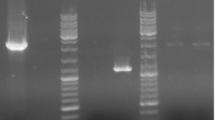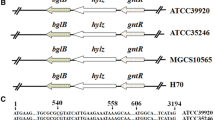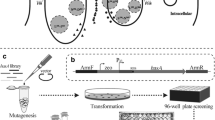Abstract
A hyaluronic acid (HA)-producing strain, Streptococcus zooepidemicus NJUST01, can grow in a serum-free agar medium, with starch as exclusive carbon source, but not glucose, sucrose, dextrine, xylose, or lactose. In this starch medium, the strain NJUST01 reproduced successively at 37°C for 60 generations, with no obvious variation on morphology and physiology, but colonies of the strain after 60th generation could not produce a clear hemolytic zone on sheep blood agar plates. Hyaluronic acid production by the strain NJUST01 was analyzed relative to the starch medium. Employing a multifactor cross experiment, an optimum medium revealed for hyaluronic acid production was composed of 5% starch, 0.3% glucose, 0.5% peptone, 0.15% MgSO4, and 2.0% K2HPO4. The amount of HA 6.7 g/l was obtained in batch fermentation on a rotary shaker at 37°C, 220 rpm for 36 h.


Similar content being viewed by others
References
Abraham N, Dov K, Moshe L, Yaffa B (1988) Method of producing high molecular weight sodium hyallronate by fermentation of streptococcus. US patent 4780414
Armstrong DC, Johns MR (1997) Culture conditions affect the molecular weight properties of hyaluronic acid produced by Streptococcus zooepidemicus. Appl Environ Microbiol 63:2759–2764
Hascall VC, Laurent TC (1997) Hyaluronan: structure and physical properties. In: Hascall VC, Yanagishita M (eds) Science of hyaluronan today. Seikagaku Corporation, Tokyo
Balasz EA (1979) Ultrapure hyaluronic acid and use thereof. US patent 4,141,973
Bitter T, Muir HM (1962) Amodified uronic acid carbazole reaction. Anal Biochem 4:330–333
Blank LM, McLaughlin RL, Nielsen LK (2005) Stable production of hyaluronic acid in Streptococcus zooepidemicus chemostats operated at high dilution rate. Biotechnol Bioeng 90(6):685–93
Chong BF, Blank LM, Mclaughlin R, Nielsen LK (2005) Microbial hyaluronic acid production. Appl Microbiol Biotechnol 66:341–351
Cooney MJ, Goh LT, Lee PL, Johns MR (1999) Structured model-based analysis and control of the hyaluronic acid fermentation by Streptococcus zooepidemicus: physiological implications of glucose and complex nitrogen-limited growth. Biotechnol Prog 15:898–910
Denki Kagaku Kogyo KK (1993) Manufacture of hyaluronic acid with Streptococcus equi. Japanese patent 93–195,924
Goa KL, Benfield P (1994) Hyaluronic acid: a review of its pharmacology and use as a surgical aid in ophthalmology and its therapeutic potential in joint disease and wound healing. Drugs 47:536–566
Kjems E, Lebech K (1976) Isolation of hyaluronic acid from cultures of streptococci in a chemically defined medium. Acta Pathol Microbiol Scand B 84(3):162–164
Khieokhachee T (1994) Kinetic studies of cheese starter cultures. Ph.D. thesis, University of New South Wales
Kim JH, Yoo SJ, Oh DK, Kweon YG (1996) Selection of a Streptococcus equi mutant and optimization of culture conditions for the production of high molecular weight hyaluronic acid. Enzyme Microb Technol 19:440–445
Laurent TC, Ryan M, Pietruszkiewicz A (1960) Fraction of hyaluronan acid. The polydispersity of hyaluronan acid from the bovine vitreous body. Biochim Biophys 42:491–495
Montgomery DC (1997) Design and analysis of experiments. Wiley, New York
O’ Regan M, Martini I, Crescenzi F, De Luca C, Lansing M (1994) Molecular mechanisms and genetics of hyaluronan biosynthesis. Int J Biol Macromol 16:283–286
Stangohl S (2000) Methods and means for the production of hyaluronic acid. US Patent 6090596
Thomas TD, Ellwood DC, Longyear VMC (1979) Change from homo- to heterolactic fermentation by streptococcus lactis resulting from glucose limitation in anaerobic chemostat cultures. J Bacteriol 138:109–111
Acknowledgement
A grant/contract sponsorship from Shedian Corporation, China, is acknowledged.
Author information
Authors and Affiliations
Corresponding author
Rights and permissions
About this article
Cite this article
Zhang, J., Ding, X., Yang, L. et al. A serum-free medium for colony growth and hyaluronic acid production by Streptococcus zooepidemicus NJUST01. Appl Microbiol Biotechnol 72, 168–172 (2006). https://doi.org/10.1007/s00253-005-0253-x
Received:
Revised:
Accepted:
Published:
Issue Date:
DOI: https://doi.org/10.1007/s00253-005-0253-x




